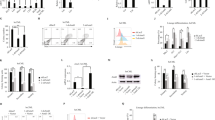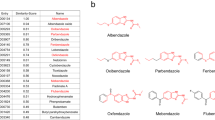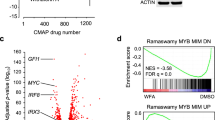Abstract
Inhibition of the bromodomain of the cAMP response element binding protein (CREB)-binding protein (CBP) and its homologue p300 is an attractive therapeutic approach in oncology, particularly in acute myeloid leukemia (AML). In this study we describe the design, optimization, and evaluation of 5-imidazole-3-methylbenz[d]isoxazoles as novel, potent and selective CBP/p300 bromodomain inhibitors. Two of the representative compounds, 16t (Y16524) and 16u (Y16526), bound to the p300 bromodomain with IC50 values of 0.01 and 0.03 μM, respectively. Furthermore, 16t and 16u potently inhibited the growth of AML cell lines, particularly MV4;11 cells with IC50 values of 0.49 and 0.26 μM, respectively. The potent CBP/p300 bromodomain inhibitors represent a new class of compounds for the development of potential therapeutics against AML.

This is a preview of subscription content, access via your institution
Access options
Subscribe to this journal
Receive 12 print issues and online access
$259.00 per year
only $21.58 per issue
Buy this article
- Purchase on SpringerLink
- Instant access to full article PDF
Prices may be subject to local taxes which are calculated during checkout








Similar content being viewed by others
References
Ogryzko VV, Schiltz RL, Russanova V, Howard BH, Nakatani Y. The transcriptional coactivators p300 and CBP are histone acetyltransferases. Cell. 1996;85:953–9.
Arany Z, Sellers WR, Livingston DM, Eckner R. E1A-associated p300 and CREB-associated CBP belong to a conserved family of coactivators. Cell. 1994;77:799–800.
Dancy BM, Cole PA. Protein lysine acetylation by p300/CBP. Chem Rev. 2015;115:2419–52.
Goodman RH, Smolik S. CBP/p300 in cell growth, transformation, and development. Genes Dev. 2000;14:1553–77.
Shiama N. The p300/CBP family: integrating signals with transcription factors and chromatin. Trends Cell Biol. 1997;7:230–6.
Chan HM, Thangue NBL. p300/CBP proteins: HATs for transcriptional bridges and scaffolds. J Cell Sci. 2001;114:2363–73.
Narita T, Ito S, Higashijima Y, Chu WK, Neumann K, Walter J, et al. Enhancers are activated by p300/CBP activity-dependent PIC assembly, RNAPII recruitment, and pause release. Mol Cell. 2021;81:2166–82.
Faiola F, Liu X, Lo S, Pan S, Zhang K, Lymar E, et al. Dual regulation of c-Myc by p300 via acetylation-dependent control of Myc protein turnover and coactivation of Myc-induced transcription. Mol Cell Biol. 2005;25:10220–34.
Conery AR, Centore RC, Neiss A, Keller PJ, Joshi S, Spillane KL, et al. Bromodomain inhibition of the transcriptional coactivators CBP/EP300 as a therapeutic strategy to target the IRF4 network in multiple myeloma. eLife. 2016;5:10483.
Iyer NG, Ozdag H, Caldas C. p300/CBP and cancer. Oncogene. 2004;23:4225–31.
Welti J, Sharp A, Brooks N, Yuan W, McNair C, Chand SN, et al. Targeting the p300/CBP axis in lethal prostate cancer. Cancer Discov. 2021;11:1118–37.
Tabayashi T, Takahashi Y, Kimura Y, Tomikawa T, Sagawa M, Nemoto T, et al. Targeting the Wnt/β-catenin signaling pathway in multiple myeloma: a possible new therapeutic approach to overcome bortezomib-resistance. Blood. 2014;124:3372.
Brooks N, Raja M, Young BW, Spencer GJ, Somervaille TC, Pegg NA. CCS1477: a novel small molecule inhibitor of p300/CBP bromodomain for the treatment of acute myeloid leukaemia and multiple myeloma. Blood. 2019;134:2560.
Giotopoulos G, Chan WI, Horton SJ, Ruau D, Gallipoli P, Fowler A, et al. The epigenetic regulators CBP and p300 facilitate leukemogenesis and represent therapeutic targets in acute myeloid leukemia. Oncogene. 2015;35:279–89.
Chen Q, Yang B, Liu X, Zhang XD, Zhang L, Liu T. Histone acetyltransferases CBP/p300 in tumorigenesis and CBP/p300 inhibitors as promising novel anticancer agents. Theranostics. 2022;12:4935–48.
Khoury JD, Solary E, Abla O, Akkari Y, Alaggio R, Apperley JF, et al. The 5th edition of the World Health Organization classification of haematolymphoid tumours: myeloid and histiocytic/dendritic neoplasms. Leukemia. 2022;36:1703–19.
Wysota M, Konopleva M, Mitchell S. Novel therapeutic targets in acute myeloid leukemia (AML). Curr Oncol Rep. 2024;26:409–20.
Kitabayashi I, Aikawa Y, Yokoyama A, Hosoda F, Nagai M, Kakazu N, et al. Fusion of MOZ and p300 histone acetyltransferases in acute monocytic leukemia with a t(8;22)(p11;q13) chromosome translocation. Leukemia. 2001;15:89–94.
Taki T, Sako M, Tsuchida M, Hayashi Y. The t(11;16)(q23;p13) translocation in myelodysplastic syndrome fuses the MLL gene to the CBP gene. Blood. 1997;89:3945–50.
Ida K, Kitabayashi I, Taki T, Taniwaki M, Noro K, Yamamoto M, et al. Adenoviral E1A-associated protein p300 is involved in acute myeloid leukemia with t(11; 22)(q23; q13). Blood. 1997;90:4699–704.
Wang L, Gural A, Sun XJ, Zhao X, Perna F, Huang G, et al. The leukemogenicity of AML1-ETO is dependent on site-specific lysine acetylation. Science. 2011;333:765–9.
Roe JS, Mercan F, Rivera K, Pappin DJ, Vakoc CR. BET bromodomain inhibition suppresses the function of hematopoietic transcription factors in acute myeloid leukemia. Mol Cell. 2015;58:1028–39.
Hay DA, Fedorov O, Martin S, Singleton DC, Tallant C, Wells C, et al. Discovery and optimization of small-molecule ligands for the CBP/p300 bromodomains. J Am Chem Soc. 2014;136:9308–19.
Taylor AM, Cote A, Hewitt MC, Pastor R, Leblanc Y, Nasveschuk CG, et al. Fragment-based discovery of a selective and cell-active benzodiazepinone CBP/EP300 bromodomain inhibitor (CPI-637). ACS Med Chem Lett. 2016;7:531–6.
Romero FA, Murray J, Lai KW, Tsui V, Albrecht BK, An L, et al. GNE-781, a highly advanced potent and selective bromodomain inhibitor of cyclic adenosine monophosphate response element binding protein, binding protein (CBP). J Med Chem. 2017;60:9162–83.
Lai KW, Romero FA, Tsui V, Beresini MH, de Leon Boenig G, Bronner SM, et al. Design and synthesis of a biaryl series as inhibitors for the bromodomains of CBP/P300. Bioorg Med Chem Lett. 2018;28:15–23.
Zou LJ, Xiang QP, Xue XQ, Zhang C, Li CC, Wang C, et al. Y08197 is a novel and selective CBP/EP300 bromodomain inhibitor for the treatment of prostate cancer. Acta Pharmacol Sin. 2019;40:1436–47.
Muthengi A, Wimalasena VK, Yosief HO, Bikowitz MJ, Sigua LH, Wang T, et al. Development of dimethylisoxazole-attached imidazo[1,2-a]pyridines as potent and selective CBP/P300 inhibitors. J Med Chem. 2021;64:5787–801.
Xiang QP, Wang C, Wu TB, Zhang C, Hu QQ, Luo GL, et al. Design, synthesis, and biological evaluation of 1-(indolizin-3-yl)ethan-1-ones as CBP bromodomain inhibitors for the treatment of prostate cancer. J Med Chem. 2022;65:785–810.
Xiang QP, Wu TB, Zhang C, Wang C, Xu HR, Hu QQ, et al. Discovery of a potent and selective CBP bromodomain inhibitor (Y08262) for treating acute myeloid leukemia. Bioorg Chem. 2024;142:106950–62.
Crabb S, Plummer R, Greystoke A, Carter L, Pacey S, Walter H, et al. A phase I/IIa study to evaluate the safety and efficacy of CCS1477, a first in clinic inhibitor of p300/CBP, as monotherapy in patients with selected molecular alterations. Ann Oncol. 2021;32:S617.
Xiang QP, Zhou Y, Zhang Y, Xu Y. CBP/p300 bromodomain: new promising epigenetic target. Visualized Cancer Med. 2022;3:3–10.
Xue XQ, Zhang Y, Liu ZX, Song M, Xing YL, Xiang QP, et al. Discovery of benzo[cd]indol-2(1H)-ones as potent and specific BET bromodomain inhibitors: structure-based virtual screening, optimization, and biological evaluation. J Med Chem. 2016;59:1565–79.
Xiang QP, Wang C, Zhang Y, Xue XQ, Song M, Zhang C, et al. Discovery and optimization of 1-(1H-indol-1-yl)ethanone derivatives as CBP/EP300 bromodomain inhibitors for the treatment of castration-resistant prostate cancer. Eur J Med Chem. 2018;147:238–52.
Hu JK, Xu HR, Wu TB, Zhang C, Shen H, Dong RB, et al. Discovery of highly potent and efficient CBP/p300 degraders with strong in vivo antitumor activity. J Med Chem. 2024;67:6952–86.
Leslie AGW, Powell HR. Processing diffraction data with MOSFLM. Evolv Methods Macromol Crystallogr. 2007;245:41–51.
Yu F, Wang QS, Li MJ, Zhou H, Liu K, Zhang KH, et al. Aquarium: an automatic data-processing and experiment information management system for biological macromolecular crystallography beamlines. J Appl Crystallogr. 2019;52:472–7.
Bailey S. The CCP4 suite: programs for protein crystallography. Acta Crystallogr Sect D Biol Crystallogr. 1994;50:760–3.
McCoy AJ, Grosse-Kunstleve RW, Adams PD, Winn MD, Storoni LC, Read RJ. Phaser crystallographic software. J Appl Crystallogr. 2007;40:658–74.
Murshudov GN, Skubak P, Lebedev AA, Pannu NS, Steiner RA, Nicholls RA, et al. REFMAC5 for the refinement of macromolecular crystal structures. Acta Crystallogr D Biol Crystallogr. 2011;67:355–67.
Emsley P, Cowtan K. Coot: model-building tools for molecular graphics. Acta Crystallogr D Biol Crystallogr. 2004;60:2126–32.
Chen VB, Arendall WB 3rd, Headd JJ, Keedy DA, Immormino RM, Kapral GJ, et al. MolProbity: all-atom structure validation for macromolecular crystallography. Acta Crystallogr D Biol Crystallogr. 2010;66:12–21.
Picaud S, Fedorov O, Thanasopoulou A, Leonards K, Jones K, Meier J, et al. Generation of a selective small molecule inhibitor of the CBP/p300 bromodomain for leukemia therapy. Cancer Res. 2015;75:5106–19.
Crawford TD, Romero FA, Lai KW, Tsui V, Taylor AM, de Leon Boenig G, et al. Discovery of a potent and selective in vivo probe (GNE-272) for the bromodomains of CBP/EP300. J Med Chem. 2016;59:10549–63.
Acknowledgements
This work was supported in part by grants from the National Key R&D Program of China (grant 2022YFE0210600), the Guangdong Province Grant for Belt and Road Joint Laboratory (grant 2022B1212050004), the Basic Research Project of Guangzhou Institutes of Biomedicine and Health, Chinese Academy of Sciences (grant GIBHBRP24-04 and GIBHBRP24-03), research initiation project of Guoke Ningbo Life Science and Health Industry Research Institute (grant 2021YJY1007 and 2022YJY0206), the Zhu Xiu Shan Talent Project of Ningbo No. 2 Hospital (grant 2023HMYQ21), Youth Innovation Promotion Association CAS (grant No. 2023372), the National Natural Science Foundation of China (grants 22007088). We thank the staff at BL19U1/BL02U1 beamlines at SSRF of the National Facility for Protein Science in Shanghai (NFPS), Shanghai Advanced Research Institute, Chinese Academy of Sciences, for providing technical support in X-ray diffraction data collection and analysis. We gratefully acknowledge the support from the Guangzhou Branch of the Supercomputing Center, the Analysis and Testing Center and the Laboratory Animal Research Center of Chinese Academy of Sciences. We also thank the Scientific Data Center of Guangzhou Institutes of Biomedicine and Health, CAS (No. 011).
Author information
Authors and Affiliations
Contributions
YX, QPX, and YZ conceived and designed the research. JKH, XT, GLL, CZ, TBW, CW, HS, XFZ, XSW, and YZ conduct the research. QPX, YX, YZ, and JKH wrote the manuscript. QPX, YX, YZ, JBS, and JKH revised the manuscript. All authors reviewed the results and approved the final version of the manuscript.
Corresponding authors
Ethics declarations
Competing interests
The authors declare no competing interests.
Supplementary information
Rights and permissions
Springer Nature or its licensor (e.g. a society or other partner) holds exclusive rights to this article under a publishing agreement with the author(s) or other rightsholder(s); author self-archiving of the accepted manuscript version of this article is solely governed by the terms of such publishing agreement and applicable law.
About this article
Cite this article
Hu, Jk., Tang, X., Luo, Gl. et al. Discovery of 5-imidazole-3-methylbenz[d]isoxazole derivatives as potent and selective CBP/p300 bromodomain inhibitors for the treatment of acute myeloid leukemia. Acta Pharmacol Sin 46, 1706–1721 (2025). https://doi.org/10.1038/s41401-025-01478-x
Received:
Accepted:
Published:
Issue date:
DOI: https://doi.org/10.1038/s41401-025-01478-x



